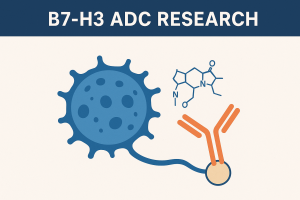B7-H3 (CD276): A Promising Target in Cancer Immunotherapy
What is B7-H3 (CD276)?
B7-H3 (also known as CD276) is a member of the B7 immune checkpoint family. It is:
- Highly expressed across a wide range of solid tumors.
- Low in normal tissues, making it an attractive therapeutic target.
- Associated with poor prognosis in many cancers.
Humans express two isoforms—2Ig and 4Ig—that may influence antibody binding and drug design. Understanding these isoforms is becoming increasingly important for biomarker development.
Latest Breakthroughs in 2025
1. Antibody–Drug Conjugates (ADCs) Lead the Way

Ifinatamab deruxtecan (I-DXd/DS-7300) received FDA Breakthrough Therapy designation in August 2025 for extensive-stage small-cell lung cancer (SCLC).
New data from the WCLC 2025 conference confirm its strong activity, positioning it as the first-in-class B7-H3 ADC.
ADCs are expected to be the near-term frontrunners for B7-H3–directed therapies.
2. CAR-T Cell Therapy Progress
- Early clinical trials (e.g., STRIvE-02) show feasible safety and measurable antitumor activity in solid tumors.
- Engineering strategies (armored CARs, regional delivery, dual-antigen logic) are being tested to improve persistence and selectivity.
3. Monoclonal Antibodies & Combinations
- Enoblituzumab (MGA271) has demonstrated immune remodeling in prostate cancer and is being evaluated in neoadjuvant settings.
- Combinations with checkpoint inhibitors, radiation, or anti-angiogenic drugs remain in development.
Why B7-H3 Matters Beyond Immunity?
Recent studies show that B7-H3 also drives tumor-intrinsic processes such as:
- Angiogenesis
- Metabolic reprogramming
- Invasion and metastasis
- Therapy resistance
This dual role (immune + tumor biology) makes B7-H3 an ideal combination therapy target.
Key Challenges Ahead
- Receptor unknowns: The true B7-H3 receptor is still unconfirmed.
- Biomarker development: Standardized assays (including isoform-specific detection) are needed.
- Safety balance: Low-level expression in normal tissues raises on-target/off-tumor concerns.
Outlook
With FDA support and a robust clinical pipeline, B7-H3 is transitioning from a “promising target” to a clinically validated pathway. Expect the next breakthroughs to clarify:
- Which tumor types benefit most.
- Which therapeutic formats (ADC, CAR-T, bispecifics) show the deepest efficacy.
- How biomarkers guide patient selection.
How RuntoGen Can Help
At RuntoGen, we support researchers and biotech developers exploring B7-H3 by offering:
B7-H3 overexpression cell lines for functional assays.
Knockout/knock-inmodels for mechanistic studies.
Custom cell line engineering services tailored to your project needs.
👉 Contact us today to accelerate your B7-H3 research and development.
